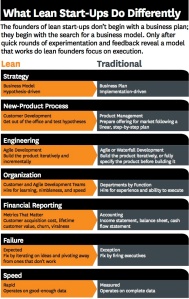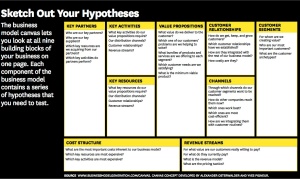In my 21 years as an entrepreneur, I would come up for air once a month to religiously read the Harvard Business Review. It was not only my secret weapon in thinking about new startup strategies, it also gave me a view of the management issues my customers were dealing with. Through HBR I discovered the work of Peter Drucker and first read about management by objective. I learned about Michael Porters’s five forces. But the eye opener for me was reading Clayton Christensen HBR article on disruption in the mid 1990’s and then reading the Innovator’s Dilemma. Each of these authors (along with others too numerous to mention) profoundly changed my view of management and strategy. All of this in one magazine, with no hype, just a continual stream of great ideas.

For decades this revered business magazine described management techniques that were developed in and were for large corporations – offering more efficient and creative ways to execute existing business models. As much as I loved the magazine, there was little in it for startups (or new divisions in established companies) searching for a business model. (The articles about innovation and entrepreneurship, while insightful felt like they were variants of the existing processes and techniques developed for running existing businesses.) There was nothing suggesting that startups and new ventures needed their own tools and techniques, different from those written about in HBR or taught in business schools.
To fill this gap I wrote The Four Steps to the Epiphany, a book about the Customer Development process and how it changes the way startups are built. The Four Steps drew the distinction that “startups are not smaller versions of large companies.” It defined a startup as a “temporary organization designed to search for a repeatable and scalable business model.” Today its concepts of “minimum viable product,” “iterate and pivot”, “get out of the building,” and “no business plan survives first contact with customers,” have become part of the entrepreneurial lexicon. My new book, The Startup Owners Manual, outlined the steps of building a startup or new division inside a company in far greater detail.
 In the last decade it’s become clear that companies are facing continuous disruption from globalization, technology shifts, rapidly changing consumer tastes, etc. Business-as-usual management techniques focused on efficiency and execution are no longer a credible response. The techniques invented in what has become the Lean Startup movement are now more than ever applicable to reinventing the modern corporation. Large companies like GE, Intuit, Merck, Panasonic, and Qualcomm are leading the charge to adopt the lean approach to drive corporate innovation. And the National Science Foundation and ARPA-E adopted it to accelerate commercialization of new science.
In the last decade it’s become clear that companies are facing continuous disruption from globalization, technology shifts, rapidly changing consumer tastes, etc. Business-as-usual management techniques focused on efficiency and execution are no longer a credible response. The techniques invented in what has become the Lean Startup movement are now more than ever applicable to reinventing the modern corporation. Large companies like GE, Intuit, Merck, Panasonic, and Qualcomm are leading the charge to adopt the lean approach to drive corporate innovation. And the National Science Foundation and ARPA-E adopted it to accelerate commercialization of new science.
Today, we’ve come full circle as Lean goes mainstream. 250,0000 copies of the May issue of Harvard Business Review go in the mail to corporate and startup executives and investors worldwide. In this month’s issue, I was honored to write the cover story article, “Why the Lean Startup Changes Everything.” The article describes Lean as the search for a repeatable and scalable business model – and business model design, customer development and agile engineering – as the way you implement it.
I’m proud to be called the “father” of the Lean Startup Movement. But I hope at least two—if not fifty—other catalysts of the movement are every bit as proud today. Eric Ries, who took my first Customer Development class at Berkeley, had the insight that Customer Development should be paired with Agile Development. He called the combination “The Lean Startup” and wrote a great book with that name.
 Alexander Osterwalder‘s inspired approach to defining the business model in his book Business Model Generation provide a framework for the Customer Development and the search for facts behind the hypotheses that make up a new venture. Osterwalder’s business model canvas is the starting point for Customer Development, and the “scorecard” that monitors startups’ progress as they turn their hypotheses about what customers want into actionable facts—all before a startup or new division has spent all or most of its capital.
Alexander Osterwalder‘s inspired approach to defining the business model in his book Business Model Generation provide a framework for the Customer Development and the search for facts behind the hypotheses that make up a new venture. Osterwalder’s business model canvas is the starting point for Customer Development, and the “scorecard” that monitors startups’ progress as they turn their hypotheses about what customers want into actionable facts—all before a startup or new division has spent all or most of its capital.
For the next month, The Harvard Business Review is providing free access to the cover story article, “Why the Lean Startup Changes Everything. Go read it.
Then go do it.
This post appeared on April 16 on Steve Blank’s blog and is republished by permission.